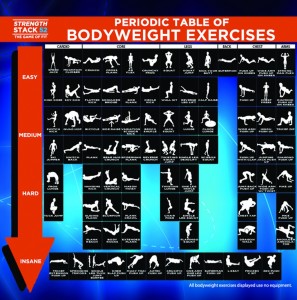For men my age, one of the more common forms of exercising is weight lifting. There are numerous forms of exercising, but one of the biggest debates is whether calisthenics or weight lifting is better for your body. Both weight lifting and calisthenics have pros and cons that the other does not have, but which of the two exercises is the best?
Weight lifting is exactly what its name says it is, lifting weights or using resistance equipment. It is mainly done to build muscle or mass, but following the right workout routine, can be used to lose weight. Calisthenics has become increasingly popular over the past twenty years. It involves exercises that do not require extra weight to be added, therefore can be considered as body
weight training. Well known calisthenics exercises include push-ups and pull-ups.
A test was conducted to see the results of weightlifting on elderly men and the subjects were fourteen 60-70 years old. None of the subjects has any prior experience in weight lifting. The study was conducted by performing exercises to train elbow flexers on one arm. This lowers the overall need of a control group because they’re other arm acts as this. Different exercises were performed three days a week over the course of twelve weeks. After the twelve weeks were over, the maximum repetitions able to be completed increased in all the subjects. The twitch torque was recorded at elbow joint angles, and it increased considerably in the arm that experienced training, but did not increase at all in the arm that did not experience the weight lifting training.
overall need of a control group because they’re other arm acts as this. Different exercises were performed three days a week over the course of twelve weeks. After the twelve weeks were over, the maximum repetitions able to be completed increased in all the subjects. The twitch torque was recorded at elbow joint angles, and it increased considerably in the arm that experienced training, but did not increase at all in the arm that did not experience the weight lifting training.
Calisthenics research was conducted on a group of Army ROTC cadets. Each cadet received multiple baseline tests on their current physical state including height, weight, overall fitness level, cardiovascular response to exercises, and Army physical fitness test. The 2 6 cadets completed calisthenic training three days a week for four weeks. Following the four weeks of calisthenics training there was not enough evidence to fail to reject the hypothesis that calisthenics improves overall fitness levels. There are many factors that may have affected this. One being that ROTC cadets already face intense military training, and the calisthenics may not have been as intense as the training they already receive. Also there was no way to prevent a bias. The cadets may have not taken it seriously and may have not worked as hard as their bodies would allow them too. With the great deal of variables that were not accounted for in this study, it is difficult to use this as an accurate representation of the benefits of calist
6 cadets completed calisthenic training three days a week for four weeks. Following the four weeks of calisthenics training there was not enough evidence to fail to reject the hypothesis that calisthenics improves overall fitness levels. There are many factors that may have affected this. One being that ROTC cadets already face intense military training, and the calisthenics may not have been as intense as the training they already receive. Also there was no way to prevent a bias. The cadets may have not taken it seriously and may have not worked as hard as their bodies would allow them too. With the great deal of variables that were not accounted for in this study, it is difficult to use this as an accurate representation of the benefits of calist
henics.
Another study analyzed the affects of calisthenics on obese children. They performed six different calisthenics exercises three times a week and this study showed that over the course of six months the average child dropped from 45% overweight to 25% overweight.
Both calisthenics and weight lifting can be used as a form of strength training, increased stamina, and improve bone health, but he most common benefit of calisthenics over weight lifting is flexibility. Calisthenics use different movements unlike weight lifting, which are essentially isolated weighted movements that are like a robot because they the exercises are almost always done in the exact same way. Weight lifting has shown to be a faster way to gain muscle mass.
Based of the tests and research, both provide positive effects on the health and fitness of a person., but whether one is better than the other is dependent on the goal of that person. The first test showed that even in an elderly person weightlifting can increase strength and muscle stamina. Although the second test showed no change, one can conclude that the calisthenics training was nearly up to par with military training because there was no decline in their overall fitness levels. The third study shows that calisthenics can be very effective in weight loss, and has led me to believe that it is the better option to increase one’s overall health, but not strength.
